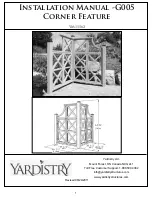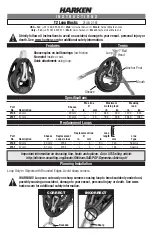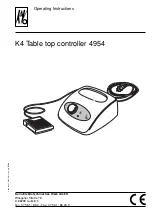
FluoroMax-3 v. 3.1 (6 Mar 2006)
Glossary
13-7
Low-pass filter
Optical component that passes light of a lower wavelength.
Luminescence
The emission of light from matter excited from a variety of proc-
esses, resulting in an electronic transition within the molecule to a
lower energy state.
See also
:
Bioluminescence
,
Chemiluminesence
,
Fluorescence
.
MCD shutter
M
ulti-
c
hannel
d
evice shutter. The Uniblitz shutter is used for its
rapid cycle time.
Mercury lamp
A light source that offers discrete narrow lines as opposed to a broad-
band radiation (e.g., xenon). Mercury lamps often are used to verify
the accuracy and resolution of a spectrometer or spectrograph.
Mirror-image rule
A sample that absorbs light for certain energy-level transitions usu-
ally exhibits an emission profile that appears to be the mirror image
of the absorption spectrum. The reason is that the same energy-level
transitions are used for excitation and emission, with the transitions
returning to the ground state as the complement to the those in the
excited state.
Molar extinction coeffi-
cient (
ε
)
The absorptivity of a particular substance, in
M
–1
cm
–1
.
Multifile
The three-dimensional acquisition datafiles collected by the software
using matrix scans or temperature scans, stored as an array of data-
files. A multifile is still stored with an
.SPC
extension. Multifiles
may be used in their entirety in FluorEssence™ as 3D files, or they
may be split up into individual two-dimensional spectra using multi-
file utilities.
Multigroup scan
This experiment type allows a time-based scan to be acquired across
more than one excitation/emission pair. Up to 16 different wave-
length pairs may be entered for a multigroup scan. The spectro-
fluorometer will cycle through each pair, integrating for the specified
time, before moving on to the next point. Use the multigroup scan for
measuring ratiometric probes (such as Fura-2 or BCECF).
Neutral-density filter
An optical element that absorbs a significant fraction of the incident
light. These filters usually are characterized by their optical density,
on a logarithmic scale. For example, a filter with OD = 1 transmits
10% of the incident light. Ideally, these filters absorb all wavelengths
equally.
See also
Absorbance
.
Optical-density effects
(Inner-filter effect)
Fluorescence intensities are proportional to the concentration over a
limited range of optical densities. High optical densities can distort
the emission spectra along with apparent intensities. For fluorescence
measurements in a 1-cm-pathlength cell, samples should have an OD
of 0.05 or less.
See also
:
Inner-filter effect
.
Phosphorescence
The emission of light or other electromagnetic radiation during the
transition of electrons from the triplet state to the ground state. Phos-
phorescence is generally red-shifted relative to fluorescence and oc-
Содержание FluoroMax-3
Страница 5: ...FluoroMax 3 v 3 1 3 Mar 2006 v 15 Declaration of Conformity 15 1 16 Index 16 1...
Страница 6: ...FluoroMax 3 v 3 1 3 Mar 2006 vi...
Страница 18: ...FluoroMax 3 v 3 1 3 Mar 2006 Introduction 0 12...
Страница 36: ...FluoroMax 3 v 3 22 Feb 2005 System Description 2 8...
Страница 96: ...FluoroMax 3 v 3 1 3 Mar 2006 Maintenance 6 12...
Страница 156: ...FluoroMax 3 v 3 1 6 Mar 2006 Automated Polarizers 10 22...
Страница 208: ...FluoroMax 3 v 3 1 6 Mar 2006 Bibliography 14 4...
Страница 210: ...FluoroMax 3 v 3 1 6 Mar 2006 Declaration of Conformity 15 2...
Страница 220: ...FluoroMax 3 v 3 1 25 Apr 2006 Index 16 10...
















































